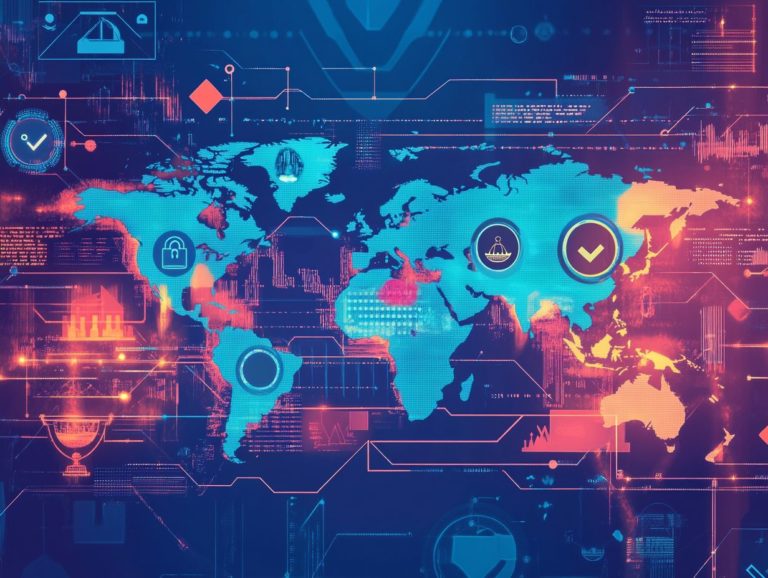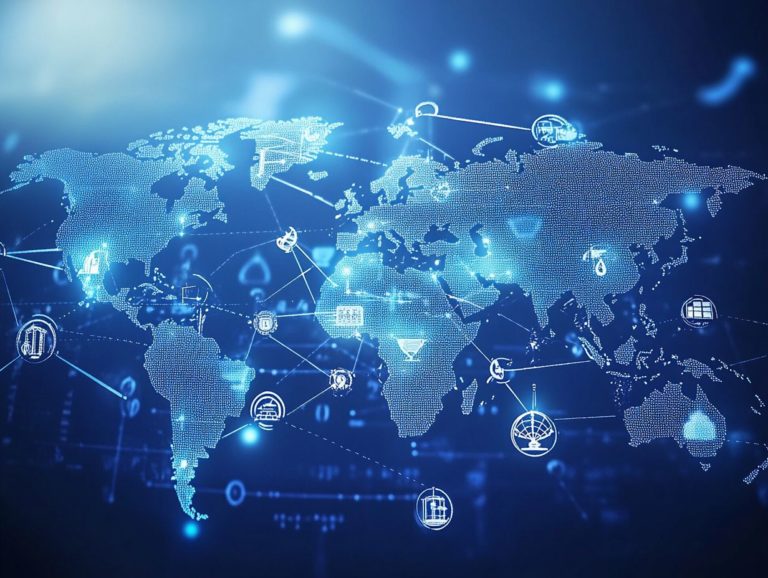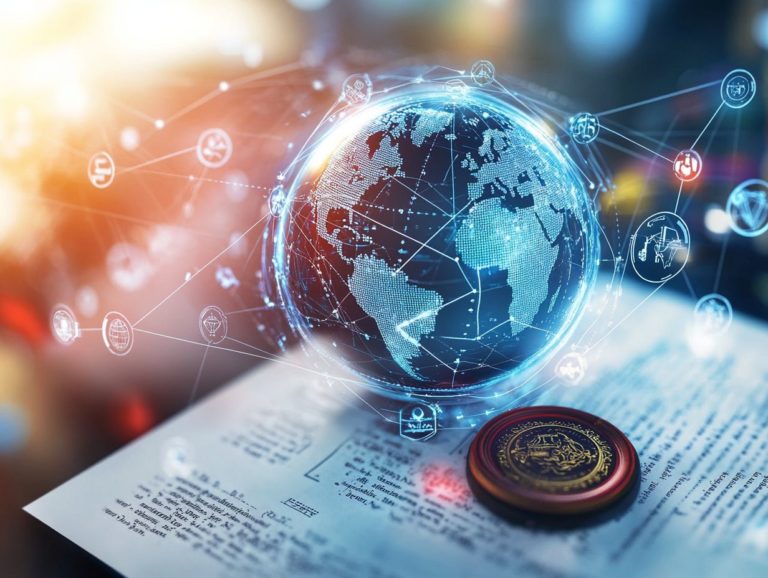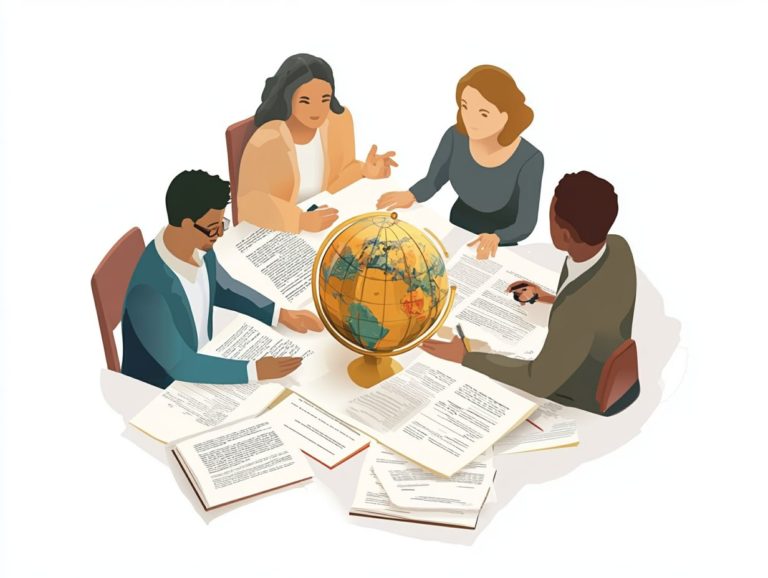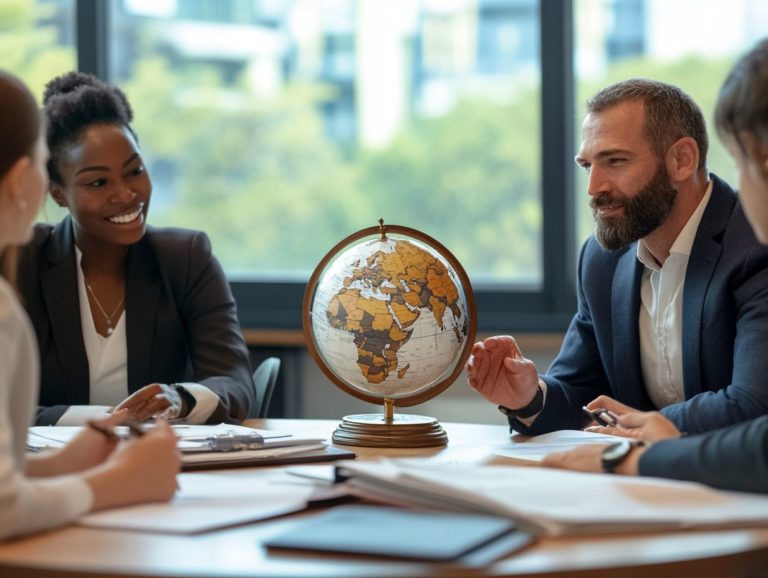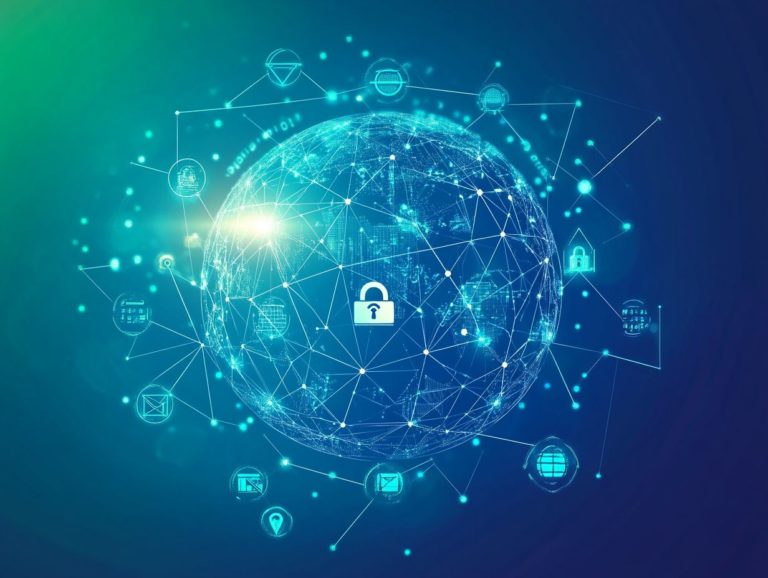5 Emerging Issues in International IP Law
In today s interconnected world, the landscape of creative rights is evolving rapidly, grappling with new challenges and dilemmas.
From protecting digital creations to ensuring access to essential medicines, the implications are vast. Technology raises unique legal questions, while counterfeit goods and online piracy threaten creators’ rights.
International organizations play a vital role in addressing these issues. Countries must unite to develop effective solutions.
This article discusses five major challenges in international IP law, highlighting key players, enforcement hurdles, and ethical considerations that shape this critical field.
Contents
- Key Takeaways:
- 1. Intellectual Property Protection in the Digital Age
- 2. Balancing Protection and Access to Medicines
- 3. The Impact of Artificial Intelligence on IP Law
- 4. The Rise of Counterfeit Goods and Online Piracy
- 5. The Role of International Organizations in IP Law
- How Can Countries Work Together to Address These Issues?
- What Are the Key Players in International IP Law?
- What Are the Challenges in Enforcing IP Rights Globally?
- How Can Developing Countries Benefit from International IP Law?
- What Are the Ethical Considerations in International IP Law?
- How Can Individuals Protect Their Intellectual Property Internationally?
- Frequently Asked Questions
- 1. What are the 5 emerging issues in International IP Law?
- 2. How is Artificial Intelligence affecting IP Law internationally?
- 3. What is digital piracy and how does it affect International IP Law?
- 4. How does biotechnology intersect with IP Law internationally?
- 5. What is cultural appropriation and how is it relevant to International IP Law?
- 6. How is International IP Law working to protect traditional knowledge and folklore?
Key Takeaways:
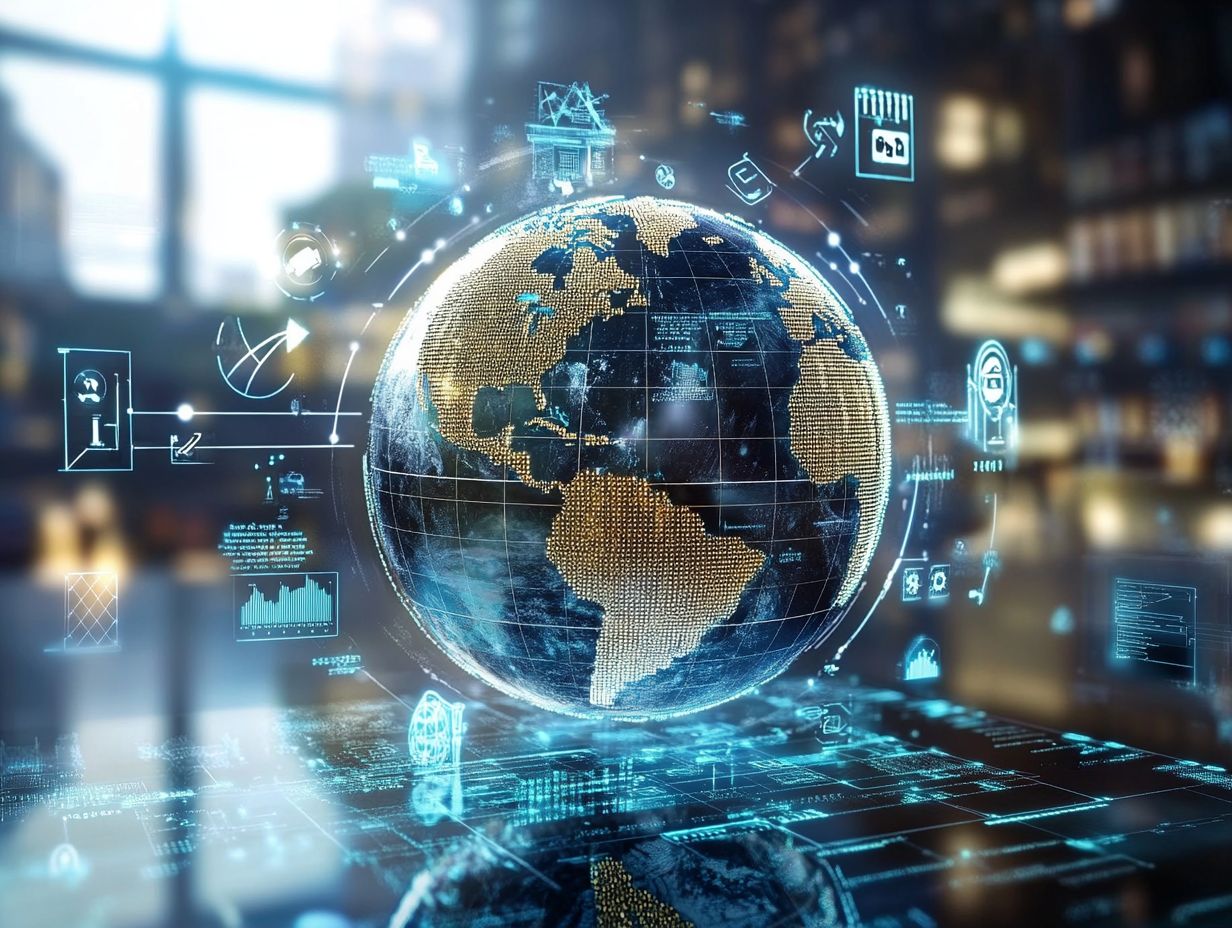
- The digital age demands immediate action to protect your rights!
- Collaboration between developed and developing countries is essential for balancing IP protection with access to medicines.
- Rapid advancements in artificial intelligence raise urgent questions about the application of IP law and protecting AI creations.
1. Intellectual Property Protection in the Digital Age
Protecting your creative rights in today’s digital landscape is more essential than ever. New forms of digital goods create a maze of ownership disputes and copyright infringements, necessitating strong legal frameworks and adaptable IP strategies.
Creative rights come in various forms, such as copyrights, patents, and trademarks. Copyright protects works like software, music, and digital art, while patents cover inventions, including algorithms or technological processes.
Trademarks preserve your brand identity in the fast-paced digital environment. Challenges are multiplying as advancements like artificial intelligence and blockchain complicate licensing agreements and IP enforcement.
AI-generated content raises questions about authorship, and blockchain’s decentralized nature blurs ownership and distribution lines. This evolving landscape requires continuous adaptation to keep your rights protected online.
2. Balancing Protection and Access to Medicines
Finding a balance between protecting creative rights and ensuring access to medicines is a formidable challenge. Patent protection can hinder public health initiatives, while compulsory licensing offers a promising solution to make essential medications available.
This delicate balance affects vulnerable populations relying on critical treatments for chronic conditions. For instance, the high prices of HIV/AIDS medications driven by patents can severely limit access.
Governments often consider compulsory licensing to produce or import generics at a fraction of the cost. Such actions help countries navigate patent restrictions while honoring creative rights, ultimately promoting public health improvements.
By leveraging compulsory licensing, we facilitate access to affordable treatments and highlight the urgent need for equitable healthcare solutions.
3. The Impact of Artificial Intelligence on IP Law
The rise of artificial intelligence (AI) is fundamentally reshaping intellectual property (IP) law. This is especially evident in ownership disputes surrounding AI-generated art. The intricacies of copyright and patent applications challenge traditional notions of human creativity and authorship.
As these technologies evolve, significant questions arise about who owns these creative outputs. This dilemma spans various fields, from music to visual arts, blurring the distinction between human and machine-generated content.
The traditional frameworks of copyright and patent law struggle to accommodate the nuances introduced by AI. This leaves potential gaps in protection for both creators and innovators. Artists and legal experts are urging a thorough reevaluation of existing laws to create clearer and more transparent guidelines.
It s crucial to address these challenges now to protect innovation and creativity while ensuring that individuals and entities rights are adequately safeguarded in this new landscape.
4. The Rise of Counterfeit Goods and Online Piracy
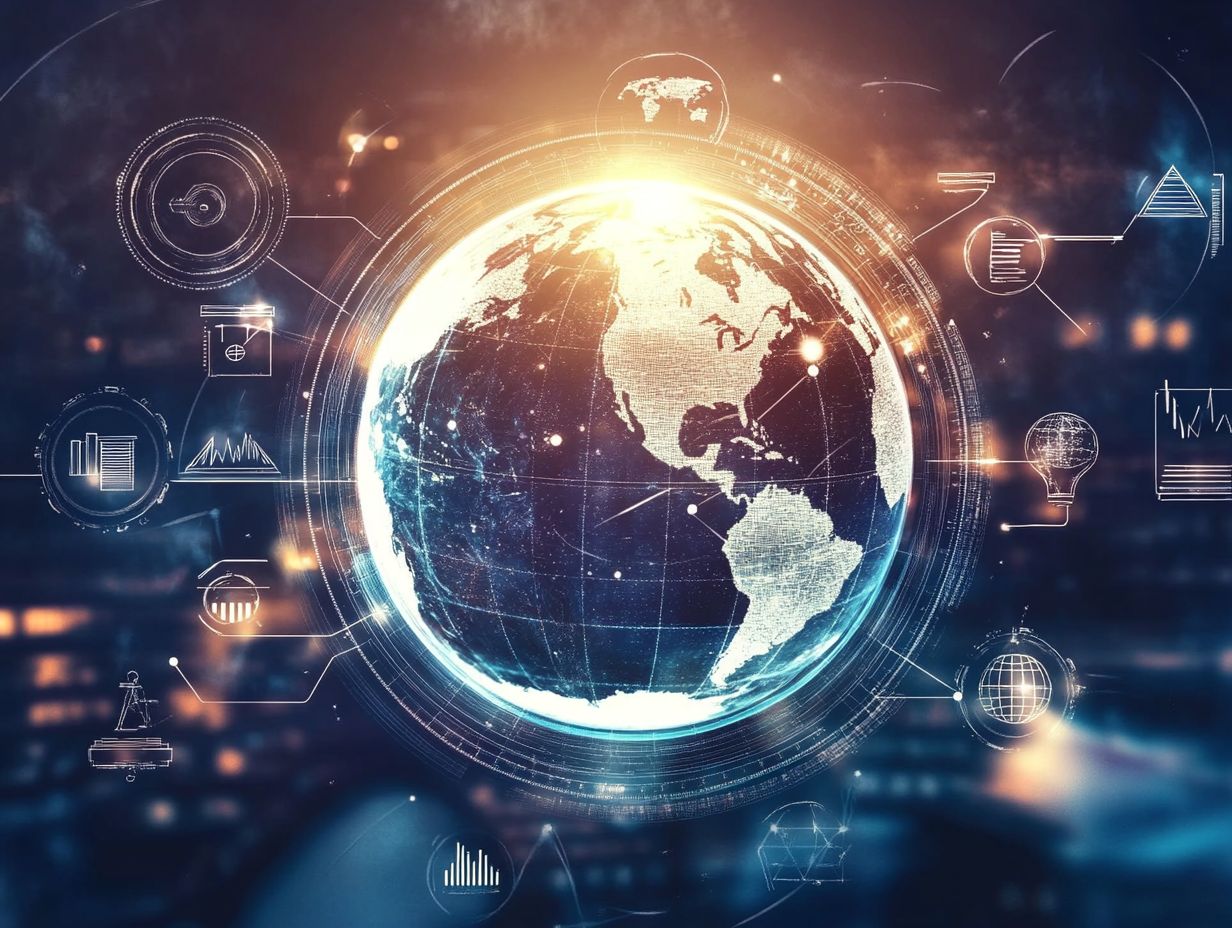
The rise of counterfeit goods and online piracy poses significant challenges to intellectual property rights. These issues undermine consumer trust and call for stronger global enforcement mechanisms, as highlighted in international IP law trends and developments, as well as more rigorous trademark registration practices.
Counterfeit goods damage real markets and confuse consumers about what products are truly valuable. As you unknowingly purchase fake products, disappointment may tarnish the reputation of authentic brands.
Online piracy also disrupts the creative industries by undermining copyright laws. This makes it increasingly difficult for artists and producers to protect their work.
To effectively tackle these threats, it s vital for governments and organizations to collaborate on unified strategies. This should include education, stronger legal frameworks, and enhanced technological solutions to identify and eliminate counterfeit and pirated content from online platforms.
5. The Role of International Organizations in IP Law
International organizations play a key role in shaping intellectual property (IP) law globally. Entities like the World Intellectual Property Organization (WIPO) establish international agreements that govern IP rights and create frameworks for managing cross-border disputes and regulatory compliance.
By promoting treaties such as the Berne Convention for the Protection of Literary and Artistic Works and the Agreement on Trade-Related Aspects of Intellectual Property Rights (TRIPS), these organizations set the stage for a cohesive approach to intellectual property challenges. Their efforts are crucial in addressing issues related to copyright, trademarks, and patents, especially in an era of increasing globalization.
The TRIPS Agreement establishes minimum standards for IP rights enforcement across member states. This fosters a more predictable and reliable environment for creators and innovators.
These initiatives show how important collaboration is in navigating the complexities of diverse national laws, ultimately aiming to create a fair and effective global IP system, especially considering the impact of AI on international IP law.
How Can Countries Work Together to Address These Issues?
Countries have the opportunity to collaborate on emerging issues in IP law. Embracing international cooperation, sharing best practices, and crafting regulatory compliance strategies can safeguard trade secrets while fostering sustainability within the innovation ecosystem, as highlighted in discussions about the future of international IP law.
By participating in joint initiatives, you can help create a framework that not only addresses enforcement challenges but also promotes responsible innovation.
Through bilateral agreements, nations can establish a unified approach to protecting intellectual property rights across borders. This ensures that creators and innovators receive fair rewards for their contributions.
Incorporating sustainability into these IP strategies encourages collaboration on green technologies and environmentally friendly practices. Ultimately, this contributes to a more equitable global marketplace.
This synergy strengthens IP protection and cultivates a culture of collaboration and advancement that benefits everyone involved.
What Are the Key Players in International IP Law?
Key players in international IP law include governmental bodies, multinational corporations, and organizations like the World Intellectual Property Organization. These entities are crucial for establishing regulatory compliance.
In addition to these prominent players, various non-governmental organizations (NGOs) also play a vital role. They advocate for creators’ rights and ensure that intellectual property protections are balanced and fair.
These stakeholders work together to create legal frameworks that protect innovations and promote international trade and economic growth. Governments often enact legislation that aligns with international treaties, while private sector companies must navigate these laws to protect their inventions and trademarks.
NGOs provide valuable insights and support, helping to raise awareness and understanding of IP rights. They ensure that the interests of both creators and consumers are represented in this complex landscape.
What Are the Challenges in Enforcing IP Rights Globally?
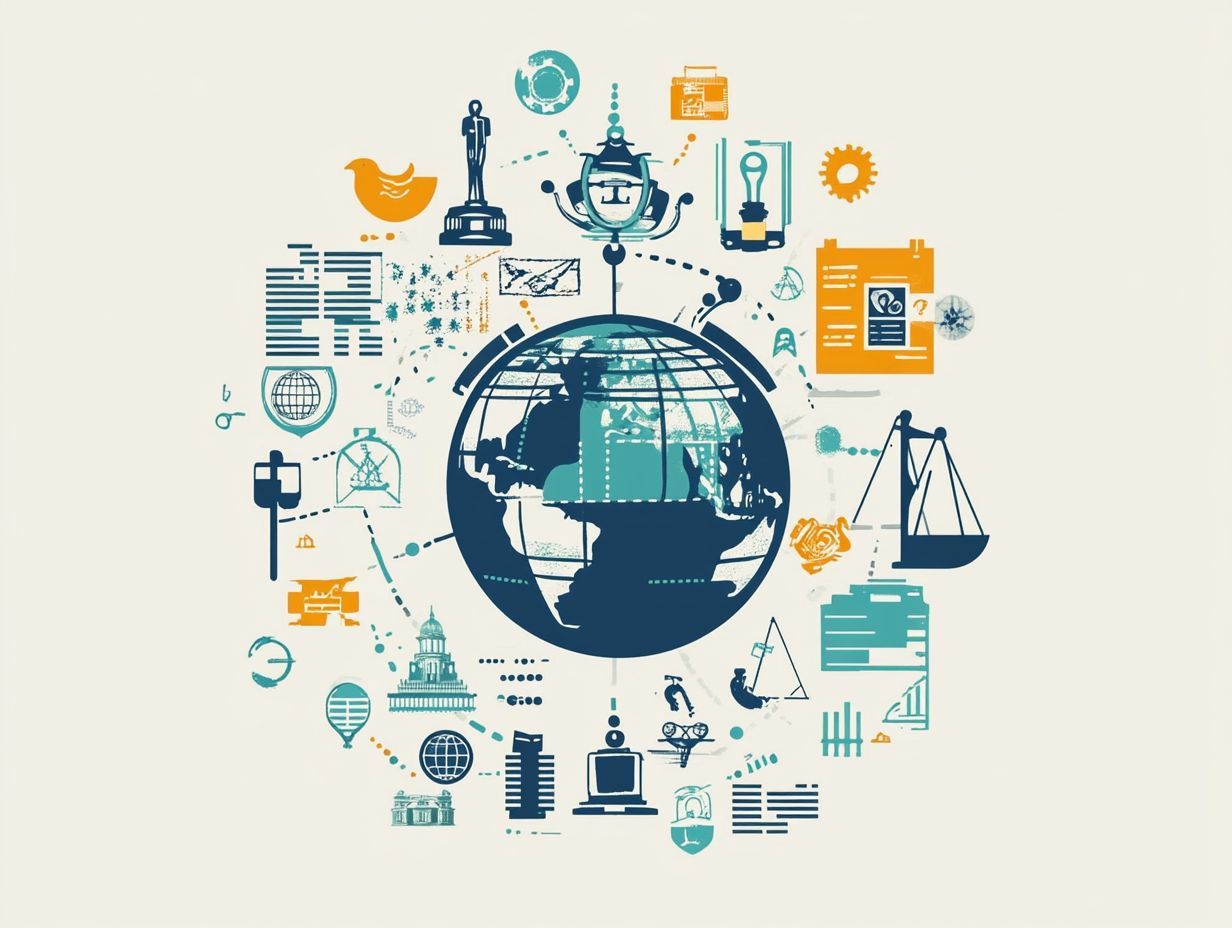
Are you curious about the challenges of enforcing IP rights globally? Enforcing these rights is fraught with issues, including a myriad of national laws and varying levels of regulatory compliance. To navigate these complexities, check out 5 essential resources for international IP law.
These hurdles can impede your ability to protect innovations and create a complex web of legal frameworks that are difficult to navigate. For businesses and creators, the disparities in enforcement tools and inconsistent judicial practices can cause confusion.
The rapid pace of digital change adds another layer of complexity, as traditional methods of protecting intellectual assets must evolve. This ongoing evolution raises critical questions about data protection, requiring strategies that balance safeguarding rights with the needs of a global marketplace.
How Can Developing Countries Benefit from International IP Law?
Developing countries can greatly thrive from international IP law by creating a system that encourages new ideas, boosts market competition, and establishes regulatory compliance. This stimulates local creativity and economic growth.
By engaging with these frameworks, countries can attract foreign investment and unlock funding opportunities that empower local entrepreneurs and inventors.
Through technology transfer initiatives sharing skills and knowledge embedded in IP agreements countries gain access to advanced methods and innovations that enhance productivity.
Success stories from countries like Kenya and India show how effective IP strategies can create vibrant tech hubs and sustainable industries.
This approach aids in economic diversification and fosters capacity building, nurturing local talent to compete on a global stage.
What Are the Ethical Considerations in International IP Law?
Ethical considerations in international IP law are crucial, especially when balancing the protection of intellectual property with access to medicines while addressing the key challenges in international IP law today to support human creativity and sustainability.
Navigating this intricate landscape often presents significant dilemmas, especially when innovation impacts public health. Excessive protection can lead to skyrocketing prices for essential drugs, effectively restricting access for vulnerable populations.
Policymakers must re-evaluate established frameworks to find a balance that rewards inventors while prioritizing society’s pressing needs.
As discussions evolve, there is growing advocacy for legislative changes that promote inclusive practices, allowing for a fair distribution of life-saving technologies without undermining the rights of creators.
How Can Individuals Protect Their Intellectual Property Internationally?
You can effectively protect your intellectual property on an international scale by understanding and utilizing licensing agreements, as well as registering copyrights and trademarks. This strategic approach safeguards your creative works across various jurisdictions.
Seek tailored legal advice, as navigating the complexities of international IP law can be challenging, especially with differing regulations in each country.
Familiarizing yourself with the various types of IP rights such as patents, trade secrets, and industrial designs empowers you to grasp how these assets can be leveraged.
To register effectively, keep thorough records and follow local laws. This ensures that your protections are not only in place but also enforceable. Engaging with experienced legal professionals can provide invaluable guidance, helping you anticipate potential pitfalls and devise robust strategies tailored to your specific needs.
Frequently Asked Questions
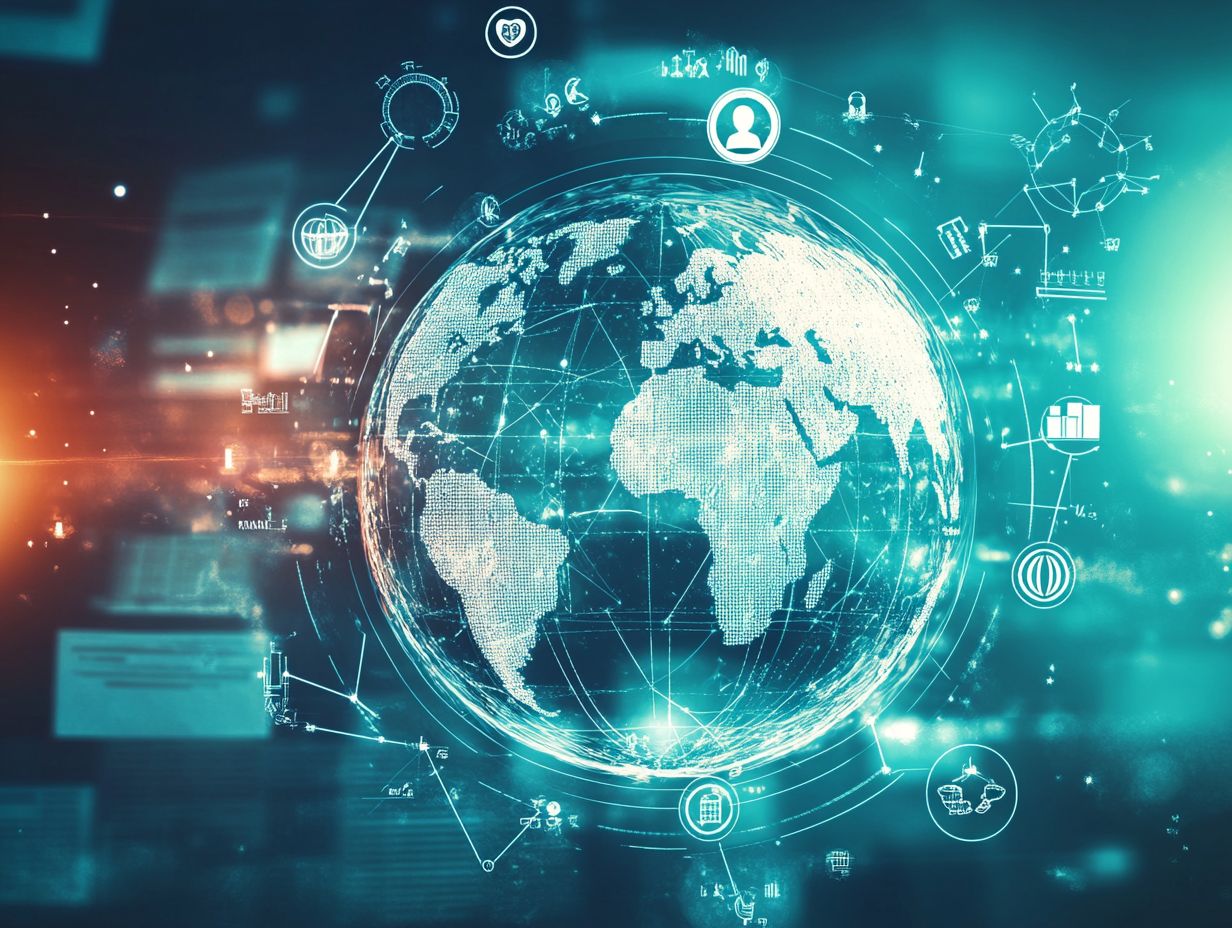
1. What are the 5 emerging issues in International IP Law?
- Artificial Intelligence and IP
- Digital Piracy
- Biotechnology and IP
- Cultural Appropriation
- Protecting Traditional Knowledge and Folklore
2. How is Artificial Intelligence affecting IP Law internationally?
Artificial Intelligence (AI) impacts IP Law in various ways. AI technology can create new innovations, raising questions about ownership rights. It also raises concerns about the infringement of existing IP rights through AI use. Moreover, AI’s role in different industries brings up issues of patentability and copyright protection.
3. What is digital piracy and how does it affect International IP Law?
Digital piracy refers to the unauthorized use, reproduction, or distribution of copyrighted material, such as music, movies, or software, through digital channels. It complicates the enforcement of copyright laws and protects the intellectual property of creators and innovators, leading to significant economic losses.
4. How does biotechnology intersect with IP Law internationally?
Biotechnology involves using living organisms to create new products and processes, raising complex IP issues. Key questions include patentability, ownership, and the ethical implications of patenting life forms. International IP Law is crucial to addressing these pressing concerns!
5. What is cultural appropriation and how is it relevant to International IP Law?
Cultural appropriation is the adoption of aspects of one culture by members of another culture without proper recognition or understanding of their significance. In IP Law, this can lead to the unauthorized use of traditional cultural expressions, such as indigenous designs or knowledge. International IP Law must consider how to protect these expressions and compensate indigenous communities for their use.
6. How is International IP Law working to protect traditional knowledge and folklore?
International IP Law addresses the protection of traditional knowledge and folklore through various means, such as the World Intellectual Property Organization’s Committee on Intellectual Property and Genetic Resources, Traditional Knowledge, and Folklore. This committee aims to develop international legal instruments and guidelines to protect traditional knowledge and cultural expressions from misappropriation and exploitation, especially considering the impact of digital technology on international IP law.
Start protecting your ideas today by exploring your options!

